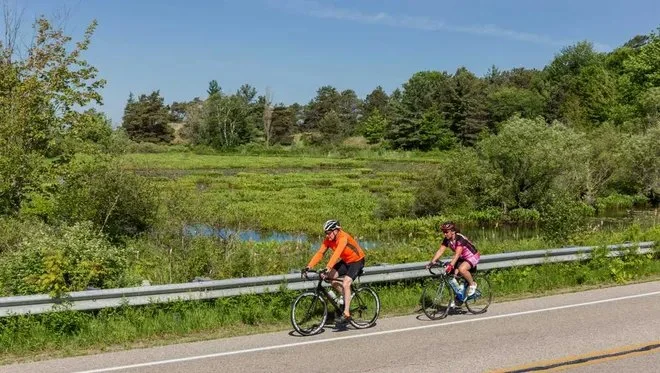
What is a Bicycle Touring Route Network?
- Overview of Bicycle Touring Route Network
- Benefits of Using a Bicycle Touring Route Network
- How to Find and Use a Bicycle Touring Route Network
- Real-Life Example of a Bicycle Touring Route
Overview of Bicycle Touring Route Network
A Bicycle Touring Route Network is a collection of designated paths, roads, and trails designed for long-distance cyclists. These networks are typically curated to provide cyclists with safe, scenic, and manageable routes across a region, country, or even continent. Whether you're an experienced cyclist or a beginner planning your first long-distance ride, a touring route network offers a structured way to explore diverse landscapes while ensuring your journey is both safe and enjoyable.
The Purpose of Bicycle Touring Routes
The main goal of a Bicycle Touring Route Network is to provide a reliable and well-marked infrastructure that supports long-distance cycling. These routes are usually mapped out to minimize dangerous roads and maximize scenic beauty, taking cyclists through natural parks, quiet country lanes, and historical sites. They’re designed to offer everything a cyclist needs for a smooth journey, including bike-friendly accommodations, accessible public transport options, and emergency support when necessary.
Benefits of Using a Bicycle Touring Route Network
1. Safety and Convenience
One of the primary advantages of using a Bicycle Touring Route Network is safety. These routes are specifically mapped out to avoid busy highways and provide cyclists with a secure environment for long-distance travel. Furthermore, they often include helpful signage, regular rest stops, and detailed maps to make navigation easier and reduce the chances of getting lost or ending up on unsafe roads.
2. Scenic and Memorable Experiences
Another key benefit is the chance to explore some of the most beautiful and unique landscapes available. Whether it’s cycling through rolling hills, coastal routes, or forested trails, a bicycle touring route network offers an immersive way to experience nature. For avid cyclists, it’s an opportunity to challenge themselves physically while enjoying the serenity and beauty of their surroundings.
3. Access to Bike-Friendly Amenities
Touring route networks often include bike-friendly accommodations and services along the way, such as bike shops, repair stations, and rest areas. Some networks are designed with specific cycling needs in mind, offering amenities like secure bike parking, overnight bike storage, and even specialized food options to cater to cyclists' nutritional requirements.
How to Find and Use a Bicycle Touring Route Network
1. Research Popular Routes
The first step in utilizing a Bicycle Touring Route Network is researching existing routes. Many countries and regions have dedicated websites or apps that provide maps, detailed descriptions, and resources for cyclists. Websites like the Adventure Cycling Association in the United States, or the EuroVelo network in Europe, offer a comprehensive list of routes with varying difficulty levels, so you can choose one that suits your fitness and experience level.
2. Plan Your Route
Once you’ve identified a route, it’s important to plan your trip. Consider your daily riding capacity, the terrain, weather conditions, and the availability of accommodations. Some routes may require several days or even weeks to complete, so ensure you have enough supplies, including food, water, and cycling gear. It’s also advisable to have a backup plan in case of unexpected changes in weather or health conditions.
3. Prepare Your Bike and Gear
For a long-distance cycling trip, your bike should be in top condition. Make sure your bike is suitable for the terrain and long hours of cycling. Touring bikes or gravel bikes are commonly used for such journeys, as they offer stability, comfort, and the ability to carry extra gear. Be sure to pack essential items like a repair kit, maps, a first aid kit, and adequate clothing for the journey.
Real-Life Example of a Bicycle Touring Route
One popular example of a Bicycle Touring Route Network is the Pacific Coast Route in the United States. This route spans approximately 1,800 miles from Canada to Mexico, taking cyclists along the stunning west coast. With scenic views of the Pacific Ocean, rugged cliffs, and charming coastal towns, this route offers an unforgettable journey for cyclists. The route is well-established, with bike-friendly accommodations and facilities along the way, making it a great choice for both novice and experienced cyclists.
Similarly, Europe’s EuroVelo network provides a vast array of cross-country routes, such as the EuroVelo 6, which stretches from the Atlantic Ocean to the Black Sea. These routes are meticulously mapped out, offering cyclists an opportunity to explore historical landmarks, picturesque countryside, and vibrant cities, all while benefiting from the network’s carefully designed infrastructure for cycling tours.
For more insights and to find the best bicycle touring products and routes, visit Cycling Guider to discover expert recommendations on cycling gear, route planning, and essential products for your cycling adventures.







 Billet BMX5.0 (2 reviews)
Billet BMX5.0 (2 reviews) Far East Children Bicycle Factory1.0 (1 reviews)
Far East Children Bicycle Factory1.0 (1 reviews) Archer Motorsports, Inc.4.0 (8 reviews)
Archer Motorsports, Inc.4.0 (8 reviews) YEP Bike Works4.0 (55 reviews)
YEP Bike Works4.0 (55 reviews) Gorham Bike & Ski4.0 (498 reviews)
Gorham Bike & Ski4.0 (498 reviews) Alchemy Bikes4.0 (37 reviews)
Alchemy Bikes4.0 (37 reviews) How to Teach Kids to Ride a Bike: A Step-by-Step Guide for Parents
How to Teach Kids to Ride a Bike: A Step-by-Step Guide for Parents Tips for Riding on Busy City Streets: Smart Strategies for Urban Cyclists
Tips for Riding on Busy City Streets: Smart Strategies for Urban Cyclists Best US National Parks for Mountain Biking: Ride Epic Trails Across America
Best US National Parks for Mountain Biking: Ride Epic Trails Across America Best Aero Helmets for Time Trials and Racing
Best Aero Helmets for Time Trials and Racing How to Clean and Lubricate Your Bike Chain Like a Pro
How to Clean and Lubricate Your Bike Chain Like a Pro 10 Must-Have Items for Long-Distance Cycling Trips
10 Must-Have Items for Long-Distance Cycling Trips